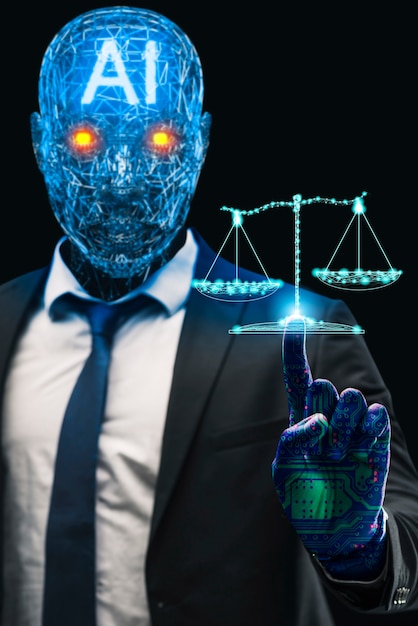The Uneasy Intersection of a Trump Presidency and Dangerous AI: A Looming Threat
The election of Donald Trump as the President of the United States in 2016 marked a significant shift in the political landscape, sparking both hope and fear among Americans and the world. Meanwhile, in the realm of science and technology, a new challenge was emerging: the development of dangerous AI. This intersection of politics and technology raises
serious ethical questions
that require urgent attention.
Presidential Policies and AI Regulation
The Trump Administration has taken a laissez-faire approach to tech regulation, allowing companies to innovate with minimal oversight. While this may be beneficial for some industries, it poses a dangerous precedent when it comes to AI development. With
no clear guidelines or regulations in place
, there is a risk that AI could be used for nefarious purposes, such as surveillance, cyber-attacks, or even autonomous weapons.
AI Ethics and Morality
Moreover, the ethical implications of AI are a matter of great concern. As machines become more intelligent and capable, they increasingly resemble sentient beings. The question of whether
AI deserves moral consideration
is a complex and contentious issue. Some argue that AI should be treated as tools, while others believe they deserve the same rights as humans. This debate becomes even more pressing in the context of a Trump presidency, given his controversial stance on issues such as immigration, human rights, and international relations.
The Role of AI in Politics
The use of AI in politics is another area of concern. With the ability to analyze vast amounts of data, predict trends, and even influence public opinion, AI can have a significant impact on elections and political discourse. There is a risk that this technology could be used to manipulate public opinion or interfere with democratic processes, raising
serious questions about transparency and accountability
.
Conclusion: Balancing Innovation and Ethics
In conclusion, the intersection of a Trump presidency and the development of dangerous AI presents a looming threat. It requires careful consideration of both the ethical implications and potential uses and misuses of this technology. As policymakers, technologists, and society at large grapple with these challenges, it is crucial that we find a way to balance innovation and ethics, ensuring that AI is used in a responsible and beneficial manner. This will require ongoing dialogue, collaboration, and education among all stakeholders.

Intersection of a Trump Presidency and Dangerous AI: A Significant and Timely Topic
I. Introduction: In today’s world, the intersection of technological advancements and politics continues to shape our society in unprecedented ways. Two such areas of immense importance are a Trump presidency and dangerous AI. While the former is shaping policy decisions and global alliances, the latter poses existential risks to humanity. This intersection is not only significant but also timely as we navigate these complex issues.
Brief Explanation
A Trump presidency, with its unique style and policy agenda, has raised concerns about various aspects of society, from immigration to international relations. Meanwhile, the rapid advancement of artificial intelligence (AI) is transforming industries and society at large, bringing both opportunities and challenges. The potential intersection between these two topics lies in their respective impacts on policy, ethics, security, and the future of humanity.
Importance in Today’s World
Understanding the intersection between a Trump presidency and dangerous AI is crucial for several reasons. Firstly, policy decisions made during this presidency could significantly influence the development and regulation of AI technologies. Secondly, as AI becomes more advanced, its potential misuse or unintended consequences could impact U.S.-China relations and global security. Thirdly, the ethical implications of AI development must be addressed, especially given the Trump administration’s stance on certain issues like privacy and human rights. Lastly, this intersection highlights the need for a proactive approach to addressing potential risks associated with AI, ensuring that societal values and human interests are prioritized in an increasingly technology-driven world.

Background
Explanation of the Trump Presidency, its Impact on Politics and International Relations
From January 2017 to January 2021, Donald J. Trump, a business magnate and television personality, served as the 45th President of the United States. His tenure was marked by controversial decisions and policies that significantly impacted both domestic and international relations.
Key Policies and Decisions
- Immigration: Trump’s administration implemented a travel ban on several Muslim-majority countries and attempted to end the Deferred Action for Childhood Arrivals (DACA) program.
- Tax Reform: The Tax Cuts and Jobs Act was passed, reducing corporate tax rates and individual income taxes.
- Health Care: The failed attempt to repeal and replace the Affordable Care Act (Obamacare) was a significant legislative endeavor.
- Foreign Policy: Trump’s “America First” policy led to withdrawals from international agreements, including the Paris Agreement and the Iran Nuclear Deal.
Explanation of Artificial Intelligence (AI), its Current State, and Potential Future Developments
Artificial Intelligence (AI) refers to the development of computer systems capable of performing tasks that typically require human intelligence. In its
Various Types and Applications
current state, AI can be categorized into three main types: narrow AI, which is designed to perform a specific task; general AI, which can handle multiple tasks and adapt to new situations; and superintelligent AI, which surpasses human intelligence. Applications of AI range from speech recognition and image processing to autonomous vehicles and predictive analytics.
Capabilities, Benefits, and Risks
Capable of processing vast amounts of data, AI offers numerous benefits such as increased productivity, improved efficiency, and enhanced decision-making. However, there are also potential risks associated with AI, including job displacement due to automation, privacy concerns, and ethical dilemmas surrounding the use of intelligent machines.

I The Trump Presidency and AI Development
A. Analysis of how the Trump administration approached AI during his presidency: During President Donald Trump’s tenure (2017-2021), the U.S. administration took a pragmatic and largely industry-driven approach towards Artificial Intelligence (AI) development and regulation. The key figures involved in AI policy within the Trump administration were Michael Kratsios, the former Chief Technology Officer of the United States, and Paul Dabirian, the Acting Assistant Secretary for Technology, Economic Development, and Innovation at the U.S. Department of Commerce.
Description of key figures, initiatives, and policies related to AI within the administration:
Michael Kratsios was a vocal advocate for increasing American competitiveness in AI technology, particularly in areas like autonomous vehicles and drones. In May 2019, the administration released a report entitled “Artificial Intelligence for American Industry: Present and Future,” which outlined current AI research efforts in various sectors and encouraged public-private partnerships to advance AI development. The Trump administration also created the Select Committee on Artificial Intelligence, which aimed to ensure that the U.S. remained at the forefront of AI research and innovation.
Assessment of the implications of these actions on AI development and regulation:
The Trump administration’s approach to AI had both positive and negative outcomes for research and innovation. On the one hand, their industry-driven focus led to increased investment in AI technologies, particularly from private companies. On the other hand, there was a lack of comprehensive regulation, which could potentially result in ethical concerns and privacy issues.
Discussion on the potential positive and negative outcomes for AI research and innovation:
The positive outcomes of Trump’s approach included increased investment in AI research and development, especially from the private sector. The administration’s emphasis on public-private partnerships led to collaborations between academia, industry, and government that further advanced AI technologies.
However, the absence of clear regulation posed potential risks. Ethical considerations around AI usage became increasingly important during Trump’s presidency, but there was no comprehensive federal framework to address these concerns. This lack of regulation could have implications for issues like data privacy, bias in AI algorithms, and the impact of AI on employment.
Evaluation of any ethical considerations surrounding Trump’s involvement in AI development:
The Trump administration’s approach to AI was largely focused on economic competitiveness and technological innovation. While this was a crucial aspect of AI development, it did not fully address the ethical considerations surrounding the use of AI technologies. Ethical concerns around data privacy, bias in algorithms, and the impact on employment were mostly left unaddressed during Trump’s presidency. This lack of attention to ethical considerations could have long-term implications for the development and deployment of AI systems in the U.S. and beyond.

Dangerous AI: Threats and Concerns
A. The advent of advanced AI brings about a myriad of potential threats and concerns that require our immediate attention.
Security risks and cyber warfare
are a significant concern, as AI systems could be exploited by malicious actors to launch sophisticated attacks on critical infrastructure, financial institutions, or even governments.
Job displacement and economic consequences
are also looming large, with AI automating various jobs and potentially leading to massive unemployment and societal upheaval. Furthermore, the moral, ethical, and societal implications of advanced AI are vast and complex, as we grapple with questions around autonomy, consciousness, and the role of humans in a world dominated by intelligent machines.
B.
With the Trump presidency, there are several ways in which the handling of these threats might be influenced.
Administration’s approach to AI safety and security
could take a more laissez-faire attitude, with less emphasis on regulation and more focus on technological solutions. This approach could be seen as risky, given the potential consequences of a catastrophic AI failure or cyber attack. On the other hand, it could also foster innovation and enable American companies to stay competitive in the global race to develop advanced AI systems.
Political ramifications of regulations
are another potential concern, with regulation being a contentious issue in any administration. Depending on the specific policies and their implementation, regulations could stifle innovation or create unintended consequences. Alternatively, they could provide a framework for ensuring safety, security, and ethical considerations in the development and deployment of advanced AI systems.

International Perspective
Overview of how other countries are dealing with the intersection between their leadership and AI development
Analysis of key players:
a. China:
China is investing heavily in AI research and development with its “Made in China 2025” strategy, which aims to make the country a global leader in AI and robotics by 2030. The Chinese government has set up several initiatives, including the National Intelligent Information Processing Technology Key Project and the Next Generation Artificial Intelligence Development Plan.
b. Europe:
Europe has a fragmented approach to AI, with each member state focusing on its own initiatives. However, the European Commission has launched a European Artificial Intelligence Alliance and a European Open Data Portal to promote collaboration between countries and ensure ethical AI development.
c. Russia:
Russia is investing in AI research, particularly in areas such as autonomous vehicles and robotics. The Russian government has established the Skolkovo Foundation, which focuses on innovation and technology development. However, concerns about ethical AI use and potential misuse of AI technology for military purposes exist.
Comparison of how the Trump presidency’s approach contrasts or aligns with these international efforts
The Trump administration has taken a more hands-off approach to AI development, focusing on promoting private sector innovation and investment. The White House released a link, which emphasizes American leadership in AI research and development while ensuring that the technology benefits all Americans. However, the lack of a comprehensive approach and significant funding for research has raised concerns about the US’s ability to compete with China and Europe in this area.
Discussion on any potential impacts on global cooperation and competition in AI research and development
The competition between the US, China, Europe, and Russia in AI research and development could lead to significant advancements in technology while also raising ethical concerns. Collaboration between countries is essential to ensure that AI is developed ethically, transparently, and with consideration for its potential impact on society. However, competition can drive innovation and push countries to invest more resources in AI research and development.
